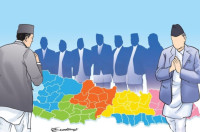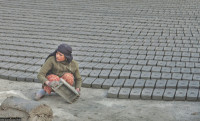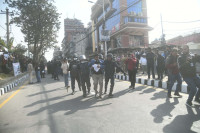Opinion
Tapping the adrenaline rush
Adventure tourism and sports are unique ways to promote development and prosperity in the mountains.
Saroj Dhakal
Our tourism industry has been able to harness these advantages in the form of mountaineering expeditions, trekking, paragliding, off-road bike rides, skydiving, hot air ballooning, zip-lining, bungee jumping, jungle safari, mountain biking, water sports like rafting and kayaking, rock climbing, triathlons, like the one held in Begnas, Pokhara, fishing, and other forms of adventure tourism and sports. The opportunities are limitless, especially if we seek to further explore options, products, and investments to harness advantages in these areas while further improving our safety, security, and hospitability standards.
Talking it out
The Mountain Festival, recently held in Pokhara from December 12 to 15, inaugurated by Prime Minister Sushil Koirala and organised by the Nepal Mountaineering Association (NMA), was a fruitful event that focussed on various issues pertaining to the prosperity of the mountainous region via development in areas of tourism, cultural promotion, value-added agriculture, and other industrial sectors that are the backbone of the mountain economy. A conference organised during the festival held vital discussions pertaining to these issues, which can have a remarkable impact on the development and promotion of prosperity in the mountains. Ganesh Gurung, former member of the National Planning Commission, made a remarkable speech on the need to promote adventure tourism to cater to the need of tourists who visit Nepal via the creation of new products. He suggested the need for the government to create a mechanism to finance technical feasibility in the development of adventure tourism, so new products along with adventure sports such as wingsuit diving, street lugging, high altitude skiing, and abseiling can be brought into forms of viable business.
The space provided to entrepreneurs at the event to discuss innovative ideas was
a vital factor, where a pitch was made for the need of a mega-scale multidisciplinary technical feasibility study to explore possibilities to innovate mountain expeditions into eco-friendly competitive sports while also helping create other products and safety technologies that can cater to the adventure industry.
The conference solemnly discussed unforeseen mishaps that have led to unfortunate accidents in the past, so we can significantly reduce risks in the future, particularly in mountaineering expeditions and high altitude trekking—the need for reliable meteorological information. A freak blizzard, subsequent avalanches, and snowstorms which resulted in the unfortunate deaths of 43 people in October in the Annapurna region; the deaths of 16 high altitude guides from an avalanche in April in the Everest region; the death of a Czech national in Myagdi in March from a parachute malfunction; the death of a South Korean national on a solo paragliding flight in Pokhara in December 2013; and the ultra-light plane crash that killed the pilot and passenger in Pokhara in October 2013 were some events that were discussed to learn how to prevent or significantly reduce risks in the future so we continue to improve on the high safety and security standards seen in Nepal’s adventure industry.
Taking discussions forward
The discussions were very timely, considerate, and well-placed. But there seems to be a need for technology entrepreneurs to join hands with adventure entrepreneurs to explore possibilities in product creation, innovation, and maintenance of security devices within the industry. There is also a need to explore adventure tourism in other countries, so we can understand the applicability of Nepal’s model for product diversification and additional revenue generation. Furthermore, an exploratory team within Nepal, with the help of the NMA, can be vital to study and design new products and sports while testing new ideas that are suitable within the topographical and cultural vicinity of Nepal.
Furthermore, the human resources involved in Nepal’s adventure industry, who are one of the best in the business, should be provided with more opportunities to further improve their soft skills in the area of language/communication and hospitability, while continuing to improve upon their core skills in specific elements of adventure tourism for expertise development. Hence, there is a need for our education system to assist the adventure tourism and sports industry. Even though Nepal can be promoted as a hub for adventure tourism and sports, we have yet to create academic institutions that cater to providing certificate-level, bachelors-level, and masters-level courses on adventure tourism and sports. This is an area where the NMA and the hotel, trekking and tourism associations should consider taking a lead. An education curriculum on adventure tourism and sports can help in developing safety and security standards, create continuous qualified human resources, attract youth towards the industry, and create experts.
There also seems to be a need for multi-stakeholder dialogue amongst government agencies, tourism entrepreneurs, tech and logistics entrepreneurs, and artists to help create sports out of many existing adventure industry products—like wild water rafting, kayaking, and mountaineering, to name the few—to prepare ourselves to add one more product into the business—broadcasting while designing acts and policies to support them. A visual presence or even a dedicated TV channel can be a powerful marketing tool, which can help reach a wider audience and possible clients who will make Nepal their destination in order to participate both in adventure tourism and adventure sports.
Adventure tourism and sports are unique ways to promote development and prosperity in the mountains to develop a climate-resilient society in climate-vulnerable Nepal. There are significant sustainable economic gains that Nepal can harness from adventure tourism and sports if more economic and climatic policies and technological thoughts are channelled in these directions.
Dhakal is the president of 8848 Inc, a company focussed on products of the Himalayas




 18.12°C Kathmandu
18.12°C Kathmandu










